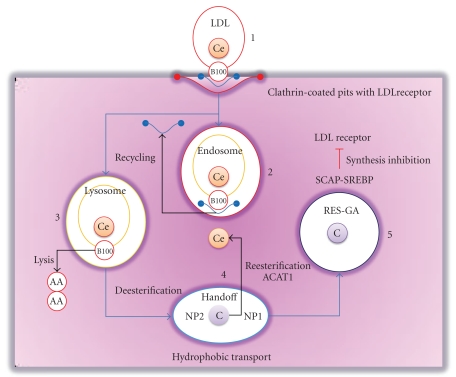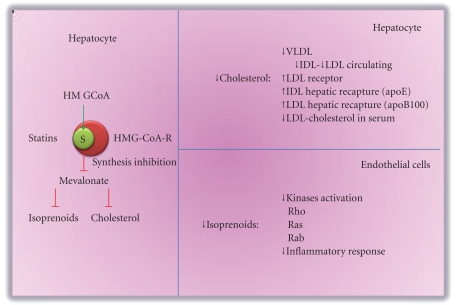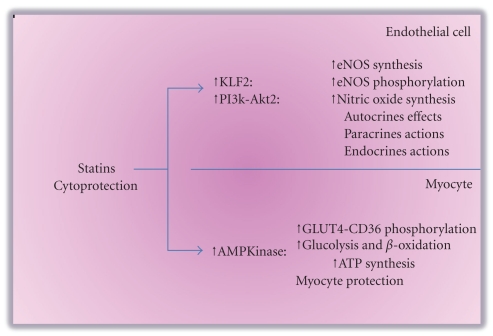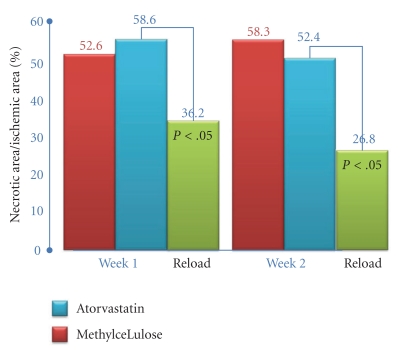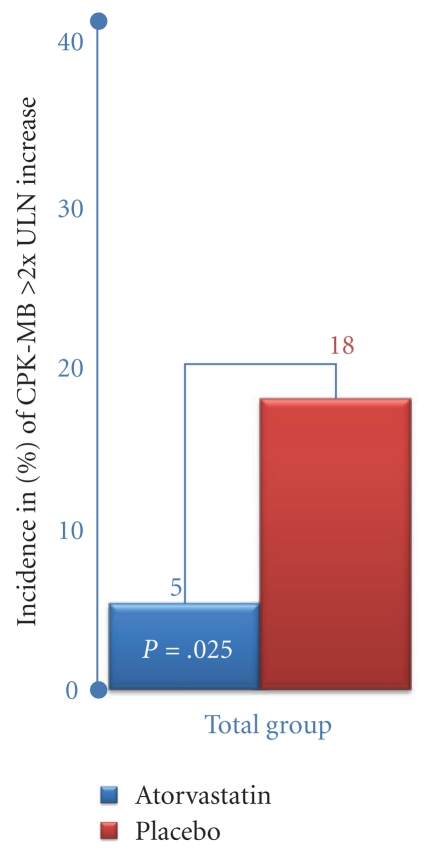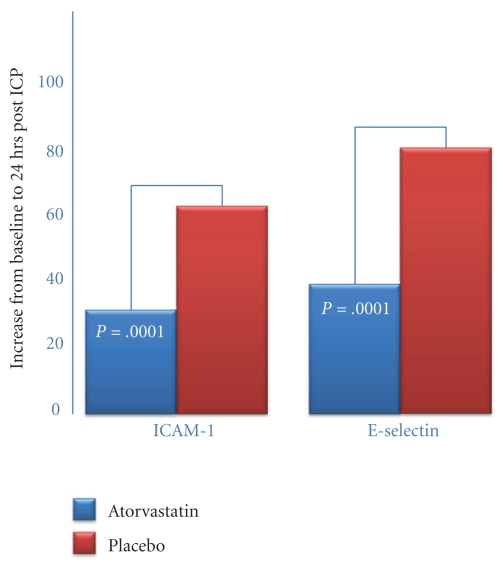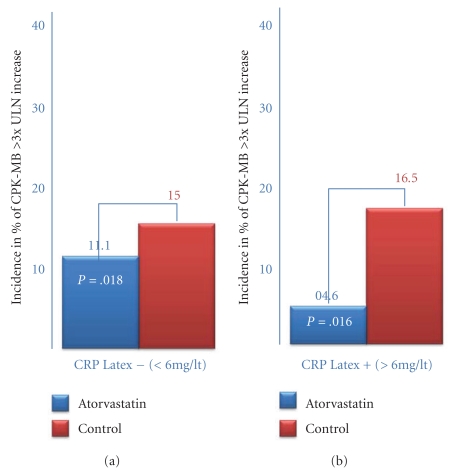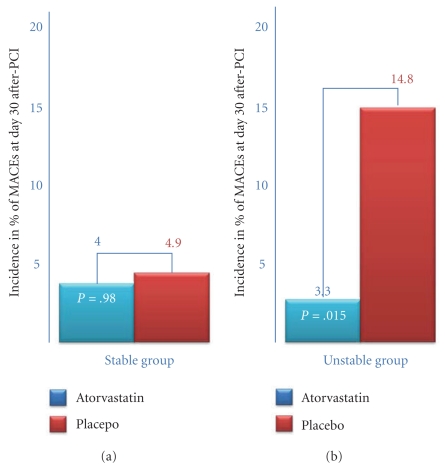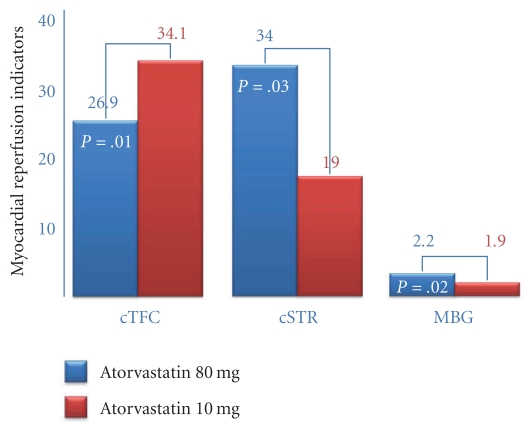Abstract
Reduction of LDL-cholesterol concentration in serum, blocking the isoprenylation of GTPases and the activation of myocyte-protective enzyme systems are three mechanisms that currently explain the lipid and non-lipid effects of statins. However, the decrease of LDL-cholesterol, the reduction of inflammation biomarkers and even the atheroregresion, as surrogate effects to the mechanisms of action of statins would be irrelevant if not accompanied by a significant decrease in the incidence of cardiovascular events. Statins like no other pharmacological group have proven to reduce the incidence of cardiovascular events and prolong life in any clinical scenario. This article review the basic and clinical evidence that support a new indication for HMG-CoA reductase inhibitors “pharmacological myocardial preconditioning before anticipated ischemia” or hyperacute use of statins in subjects with any coronary syndrome eligible for elective, semi-urgent or primary percutaneous coronary intervention: ARMYDA-Original, NAPLES I-II, ARMYDA-ACS, ARMYDA-RECAPTURE, Non-STEMI-Korean, Korean-STEMI trials.
1. Introduction
The inhibitors of Hydroxy Methyl Glutaryl-Coenzyme A Reductase (I-HMG-CoA-R) or statins have become the cornerstone of drug therapy that aimed at reducing cardiovascular risk. Statins are the pharmacological group with the highest reduction power of the serum LDL cholesterol concentration, apart from other lipid and pleiotropic actions. Therefore, their therapeutic efficacy can be explained if we remember that LDL cholesterol modified by oxidation becomes an epitope, which provokes along with other endothelial-vascular lesion factors, a pathological sequence with atherosis, endothelial activation-dysfunction lesion, atherosclerosis, and atherothrombosis. Thus, statins have become the most important pharmacological weapon for cardiovascular risk reduction when associated to atherosclerosis.
This paper reviews the most important pharmacological properties of statins, starting with new information on the mechanisms of action and effects that explain the reduction of LDL cholesterol concentration in serum, as well as nonlipid or pleiotropic effects. These basic concepts will be the foundations that will lead us to a better understanding of the impact of statins in new clinical applications, specially focusing on the role they play as reducers of Percutaneous Coronary Intervention (PCI) complications in individuals with stable and unstable coronary syndromes with and without ST segment elevation.
2. Statins: Mechanism of Action
The first statin extracted from Penicillium citrinum was discovered by Dr. Akira Endo in the 70s. Based on the knowledge of cholesterol synthesis from acyl and acetyl-CoA, Endo showed that compactin when competing with the HMG-CoA was an inhibitor of the enzyme that regulates cholesterol synthesis. Statins specifically compete with HMG-CoA for the catalytic site of its reductase (HMG-CoA-R). This competition inhibits the metabolic pathway of HMG-CoA into mevalonate, a precursor molecule for the synthesis of cholesterol and other molecules such as the isoprenoids, Farnesyl and Geranyl Pyrophosphates [1, 2]. Endo's discovery was complemented and made clinically relevant by the studies of Joseph Goldstein and Michael Brown. Both researchers discovered the cellular receptor for LDL cholesterol (LDL-R) and described three concepts that would revolutionize medicine. Such concepts gave them a Nobel Prize in 1985 [3]. These “classical” concepts of and new data on the mobilization of intracellular cholesterol are presented as follows (see Figure 1).
Figure 1.
Regulation of LDL-R in 5 steps. Step 1. The LDL is recognized in apo-B100 by the LDL-R located in the membrane structures “clathrin-coated pits.” Step 2. It forms an endocytic vesicle or endosome containing LDL and LDL-R, the LDL-R is dissociated through lowering of the pH within the endosome, and the LDL is transferred to the lysosomes. Step 3. In lysosomes, apo-B100 is hydrolyzed into amino acids and cholesteryl ester is deesterified by enzymatic hydrolysis. Step 4. Nonesterified cholesterol (hydrophobic) is transported to the cell membranes by the “hydrophobic handoff mechanism”; in this mechanism Niemann Pick 2 and 1 proteins form a hydrophobic core containing nonesterified cholesterol. Step 5. Nonesterified cholesterol is transferred by the binomial NP2-NP1 to cell membranes, its concentration in the Sarcoplasmic Reticulum/Golgi Apparatus membranes is the signal that inhibits the dissociation of SCAP-SREBP and thus blocks the synthesis of LDL-R.
(a) Receptor-Mediated Endocytosis —
Each LDL macromolecule contains an average of 1500 molecules of cholesteryl ester; it gets into cells through the existence of LDL-R. These receptors are glycoproteins with 5 domains, embedded in convex structures of the cell membrane, formed by clathrin protein, and called “clathrin-coated pits.” These structures serve as gathering places for cell surface receptors aimed at endocytosis. Once the LDL cholesterol is taken up by the LDL-R, an endocytic vesicle called endosome or receptosome is formed. Within the cell the LDL-R leaves the endosome and returns to the cell membrane; this dissociation is favored by a decrease in pH within the endosome. The LDL is transferred from the endosomes to the lysosomes and within them; both lipids and apoproteins are hydrolyzed, the first one into nonesterified cholesterol and the second into amino acids [3–5].
(b) Self-Regulation of the Receptor —
Nonesterified cholesterol due to its being hydrophobic cannot move freely within the cell cytoplasm. The transport means of nonesterified cholesterol from the lysosome to the cell membranes was recently described by Brown and Goldstein and has been called “hydrophobic handoff mechanism.” In this process proteins Niemann Pick 2 and 1 form a “hydrophobic core” that contains and carries the nonesterified cholesterol. The concentration of cholesterol in cell membranes, including the membrane of the Sarcoplasmic Reticulum/Golgi Apparatus system, is the signal to regulate the connection between the transcription factor, Sterol Regulatory Element Binding Protein (SREBP), and its anchor protein SREBP-Cleavage Activating Protein (SCAP). Cytoplasmic sequestration of SREBP by SCAP prevents the synthesis of LDL-R and other enzymes involved in cholesterol synthesis, especially HMG-CoA-R. The higher the concentration of cholesterol in cell membranes, the greater the inhibition of the synthesis of LDL-R. Free nonesterified cholesterol in the cytoplasm is reesterified by Acyl-CoA Cholesterol Acyl Transferase 1 (ACAT1) and then it can be integrated to the cellular metabolism [3–6].
(c) Recycling of the Receptor —
The LDL-R plays an inside-out cell cycle every 10 minutes, so each LDL-R makes more than hundred cycles during its average 20-hour life. The cell cycle of the LDL-R can be interrupted by the action of the recently discovered Proprotein Convertase Subtilisin Kexin type 9 (PCSK9) [7].
Thus, by inhibiting the HMG-CoA-R, the mechanisms that allow statins to reduce concentrations of cholesterol in serum are the following: (a) reduction of cholesterol hepatic synthesis and therefore a reduction in the synthesis of VLDL, an IDL and LDL precursor; (b) reduction in the concentration of cholesterol in the membranes of the hepatocyte and increased transcription, synthesis and expression of LDL-R with an affinity for IDL (in apo-E) and LDL (in apo-B100); (c) increase in hepatic uptake of IDL and LDL and cholesterol hepatobiliary elimination [8, 9]. The cholesterol-lowering power of statins is directly related to the number of links they establish with the catalytic site of HMG-CoA-R; atorvastatin establishes 8 links while rosuvastatin 9, and therefore the inhibition coefficients of 50% (IC-50) of the enzymatic action of HMG-CoA-R are of 5.4 and 8.2 nanomoles, respectively [8–12].
3. Statins—Effects on Cholesterol, Biomarkers of Inflammation, and Myocyte Protection: Cholesterol Reduction
The average reduction of cholesterol in serum is a function of the statin and its dosage; 10 mg of atorvastatin or rosuvastatin 5 mg achieve an average reduction of 35% in the baseline value of LDL cholesterol, while the maximum therapeutic doses 80 mg and 40 mg, respectively, produce an average reduction of 50% and 55%. This effect is independent of the hydrophilicity (facilitated diffusion by Organic Anion Transporters of Polypeptides or OATP) or lipophilicity (direct diffusion) of the statin. These data allows us to calculate the optimal therapeutic dose of a statin according to baseline LDL cholesterol, the goal regarding the cardiovascular risk level and the treatment gap [13–15].
Reduction in Inflammation Biomarkers —
Statins not only reduce the concentration of LDL cholesterol in serum, as mentioned above, inhibition of the synthesis of mevalonate by statins also blocks the synthesis of isoprenoids (Farnesyl and Geranyl Pyrophosphates). In the phenomenon of endothelial activation, isoprenoids play a very important role [16, 17]; in endothelial cells, binding of oxidized LDL cholesterol to its LOX Receptor activates the expression of its inflammatory phenotype; during such process, the intracellular switch is the isoprenylation of small G type proteins (smgs). These proteins are called G for their guanosine content, when nonactive, smgs are “floating” in the cellular cytoplasm linked to Guanosine Diphosphate (GDP), and its activation depends on the presence of isoprenoids and the Guanosine Exchange Factor (GEF). With the participation of both molecules, the GDP acquires a phosphate group and becomes Guanosine Triphosphate (GTP); thus, the inactive smgs acquire the characteristic of GTPases, migrate, anchor themselves to the cell membrane, and exert their phosphorylating action on various substrates for activation of multiple enzymatic cascades. GTPases are divided into several enzyme families, the most important are the so-called Ras, Rho, and Rab, each stimulating different cellular processes involved in the inflammatory process (e.g., the smg Ras modulate cell division and growth, the smg Rho proteins activate the cell cytoskeleton, and the smg Rab regulate intracellular vesicular movement) (see Figure 2) [18, 19].
Figure 2.
Statins reduce cholesterol, and isoprenoids synthesis. The statins inhibit HMG-CoA-R and block the synthesis of mevalonate, cholesterol, and isoprenoids. In the hepatocyte, the reduction in cholesterol synthesis determines a reduction in VLDL synthesis and increase in the synthesis of LDL-R; thus, the reduced production of VLDL, IDL, and LDL and increased elimination of circulating IDL, and LDL, explain the reduction in LDL concentration. In the endothelial cells the reduction in the synthesis of isoprenoids determines a reduction of the inflammatory response mediated by inactivation of smgs from different families (Rho, Ras, Rab).
Thus, inhibition of isoprenoid synthesis by statins reduces isoprenylation of smgs proteins and blocks in different degrees the inflammatory response initiated by oxidized LDL cholesterol binding to LOX-R. Inflammatory endothelial activation initiated by the binding of other ligands to their receptors (e.g., angiotensin II to AT1-R or AGEs to RAGEs) is also generated from a process of smgs and G proteins isoprenylation; this explains why the anti-inflammatory effect of statins is not proportional to the reduction of LDL cholesterol; its anti-inflammatory capacity goes beyond this fact due to its potential to inhibit the switch of inflammatory endothelial activation, regardless of the stimulus [20, 21].
Multiple in vitro evidence has been published, in vivo in experimental animals and in vivo in individuals with atherosclerosis such evidence has shown that statins attenuate vascular endothelial inflammatory process of atherosclerosis itself. This endothelium-vascular inflammatory attenuation is independent but synergistic with LDL cholesterol reduction. The following are among the most important pieces of evidence. Dr. Jain's team at Harvard proved in vitro that statins promote on endothelial cells the expression of Kruppel-Like Factor 2 (KLF2), transcription factor for the synthesis of eNOS and thrombomodulin [22]. Thus, statins stimulate the synthesis of eNOS, an enzyme responsible for the production of nitric oxide, which among its many actions promotes on the endothelial cell the intracytoplasmic sequestration of the transcription factor NFκB (group of “master” transcription factors of the inflammatory response). The translation in vivo, in the experimental animal, of the anti-inflammatory effect of statins has been published by several researchers. For example, in the animal model of aortocoronary atherosclerosis in mice, when blindly compared with placebo, statins decrease “acutely” the monocyte infiltration into atherosclerotic aortocoronary areas [23]. This phenomenon is equivalent to the in vivo demonstration in humans of “acute” reduction of the inflammatory activity in aortas with atherosclerosis in subjects treated with statins. By using 18FDG-PET, it has been shown that the administration of atorvastatin significantly reduced inflammatory activity in human aortas with atherosclerosis; this change in inflammatory activity occurs within days and was not associated with significant changes in the concentration of LDL cholesterol in serum [24].
Myocyte Protection —
Statins in experimenting animals have shown a myocyte-protective effect, this effect is independent of LDL-cholesterol reduction and anti-inflammatory effect and have been associated with the activation of two cellular protective enzyme systems, the Reperfusion Ischemic Salvage Kinases pathway (RISK pathway) and the AMP-activated Kinase (see Figure 3) (AMPK) [25–30].
Figure 3.
Statins, mechanisms, and myocyte-protective effects. Statins increase the expression of KLF2 and eNOS synthesis and also increase the activation of eNOS and nitric oxide production. In the myocyte the activation of AMPK increases the income and energy substrate utilization, as well as the production of ATP.
RISK Pathway —
Nitric oxide production by activation of enzymatic cascade PI3Kinase-Akt2-eNOS is a physiological process of cell protection against ischemia and statins have been proven to potentiate this process. However, Yellon and his colleagues have shown in experimental animals that “chronic” experimental administration of statins prevents the production of nitric oxide through RISK pathway. This inhibition is due to the overexpression of the Phosphatase Tensin (PTEN) with an antagonistic action towards PI3Kinase. This blockade of the RISK pathway can be recaptured with the administration of a statin reload [31]. Mensah demonstrated in experimental rats subjected to myocardial ischemia and postischemia reperfusion that the quotient (myocardial necrosis/ischemia) after reperfusion was significantly reduced by administration prior to the ischemia of an acute dose (day 1 and day 3) of atorvastatin. This myocyte-protective effect was canceled when the statin was administered for longer periods (1 and 2 weeks) before induction of myocardial ischemia. The cancellation of the myocyte-protective effect was associated with a significant increase in the concentration of PTEN. The most important finding of this series of experiments was the evidence that, in animals treated for 1 or 2 weeks with atorvastatin, the reload of atorvastatin in day 1 significantly reduced the quotient (myocardial necrosis/ischemia), which, means that it “recaptured the RISK pathway.” (see Figure 4) The hypothesis is that statins reload manages to inhibit the expression of PTEN and enhances the expression of PI3Kinase-Akt2-eNOS with increased production of nitric oxide [31]. This evidences provided the rationale and name of the study ARMYDA-RECAPTURE analyzed as follow.
Figure 4.
Statins and recapture of the RISK pathway. This modified graphic of Mensah's work, shows how the quotient (necrosis/ischemia) is similar in rats treated for 1 or 2 weeks with methylcellulose (red bars) or atorvastatin (blue bars). This loss of myocyte-protective effect is “recaptured” significantly with the reload of atorvastatin (green bars).
AMPKinase —
This enzyme is considered the energetic switch of the ischemic, cell. In the ischemic cell there is an inversion of the quotient ATP/AMP by increased cytoplasmic concentration of AMP (ADP + ADP = 1 ATP + 1 AMP). The AMP increase is the signal that activates the gamma subunit of the AMPK and initiates multiple phosphorylation substrates (AMPK-kinases). Among the substrates activated by AMPK are the glucose transporters (GLUT4), fatty acid transporters (CD36) and key enzymes of the pathways of glycolysis and beta-oxidation. Thus activation of AMPK increases cellular entry, the use of glucose and free fatty acids, as well as the production of ATP. There is much evidence that molecules such as adiponectin, metformin, and statins are indirect AMPK activators, thereby exercising a myocyte-protective effect, especially in scenarios of myocardial ischemia [28]. To summarize, the RISK pathway and the AMPK are activated by statins in an LDL-independent manner. The RISK pathway increases nitric oxide production and AMPK increases cellular income and utilization of glucose and fatty acids which optimizes the energy efficiency of the ischemic cell [25–31].
4. Statins: Clinical Effects in Percutaneous Coronary Intervention (Hyperacute Use)
Based on observational studies, most notably Chang's [32] randomized studies were designed and provided solid evidence resulting in new options for therapeutic use of statins in subjects undergoing elective, semiurgent (12–48 hours of “interventional window”), and primary Percutaneous Coronary Intervention (PCI). The reduction in the risk of Myocardial Infarction-PCI associated (MI-PCI associated) with a statin load prior to PCI is undoubtedly an important therapeutic benefit that is changing the therapeutic approach on the hemodynamics prelude, which will probably give statins a new indication (pharmacologic preconditioning against anticipated myocardial ischemia) [33–42]. The Italian group led by Germano Di Sciascio began, with its publication in 2004, the series of formal clinical studies supporting the concept of myocardial preconditioning by statin against anticipated myocardial ischemia. This series of studies include the following: ARMYDA-Original [34], ARMYDA-CAMs [35], NAPLES I-II [36, 37], ARMYDA-ACS [38], ARMYDA-RECAPTURE [39], ARMYDA-AMI [40], still under recruitment stage, and the recently published Koreans studies on Non-STEMI [41] and Statin-STEMI [42] (see Table 1).
Table 1.
Randomized trials with statins in percutaneous coronary intervention. This table is a summary of the 8 randomized trials (versus placebo or versus control groups) published with statins in individuals under PCI. All studies except Vaselka's have shown positive results for the use of statins prior to PCI. The results in individuals with elevated CRP before PCI (NAPLES II) and in individuals with ACS (ARMYDA-ACS y ARMYDA-RECAPTURE, ACS soubgroup), are particularly favorable. MI-PCI-A: Myocardial Infarction-PCI associated. MACE: Mayor Adverse Cardiovascular Events. MRI: Myocardial Reperfusion Indicators.
| Trial | Interventional scenario | Treatment | Primary end point | |
|---|---|---|---|---|
| ARMYDA-Original N 153 naive (76/77) |
Non-ACS | Atorvastatin versus placebo 40 mg/7 days pre-PCI | ↓ MI-PCI-A. CPK-MB > 2x ULN 05.0% versus 18.0% (P = .025) | |
| NAPLES I N 451 naive (226/225) |
Non-ACS | Various statins versus control Different doses >72 hr pre-PCI |
↓ MI-PCI-A. CPK-MB > 3x ULN 08.0% versus 15.6% (P = .012) | |
| NAPLES II N 668 naive (338/330) |
Non-ACS | Atorvastatin versus control 80 mg/24 hr pre-PCI | ↓ MI-PCI-A. CPK-MB > 3x ULN 09.5% versus 15.8% (P = .014) ↓ MI-PCI-A. CPK-MB > 3x ULN 04.6% versus 16.5% (P = .016) (subgroup CRP > 6 mg/lt) |
|
| ARMYDA-ACS N 171 naive (85/86) |
Non-STEMI ACS | Atorvastatin versus placebo 120 mg/12 hr pre-PCI | ↓ MACE day 30. 05.0% versus 17.0% (P = .01) ↓ MI-PCI-A. CPK-MB > 2x ULN 0.5% versus 15.0% (P = .04) |
|
| ARMYDA-REC N 383 preTx (192/191) |
Non-STEMI ACS 47% | Non-ACS 53% | Atorvastatin versus placebo 120 mg/12 hr pre-PCI | ↓ MACE day 30. 03.7% versus 09.4% (P = .037). ↓ MACEs day 30. 03.3% versus 14.8% (P = .015) (subgroup ACS) |
| Non-STEMI Korean N 445 naive (220/225) |
Non-STEMI ACS | Rosuvastatin versus control 40 mg/16 hr pre-PCI | ↓ MI-PCI-A. CPK-MB > 2x ULN. 05.8% versus 11.4% (P = .035). | |
| STEMI Korean N 171 naive (86/85) |
STEMI ACS | Atorvastatin high versus low dose 80 mg versus 10 mg in primary PCI | ↓ MACE day 30. 05.8% versus 10.6% (P = .26) ↑ MRIs min 90 after PCI. All indicators P < .05 |
|
| Vaselka N 200 naive (100/100) |
Non-ACS | Atorvastatin versus Control 80 mg/48 hr pre-PCI | ↓ MI-PCI-A. CPK-MB > 3x ULN 10.0% versus 12.0% (P = .065) | |
Before addressing the analysis of these studies, it is important to review the definition of MI-PCI associated, its frequency, and prognosis implications. Since 2007, the diagnosis criteria for MI-PCI associated is 3 times greater than the normal maximum value of CPK-MB and/or troponins (before 2007 the criteria was 2 times more) [43]. The MI-PCI associated is common, its incidence has been reported as high as 70%, and its pathogenesis involves several factors: some of the most important are the endothelial-vascular size and condition of the compromised territory, the spontaneous microembolization, as well as the microembolization induced by the triad catheter-balloon-Stent with distally compromised microcirculation, collateral circulation, and myocardial ability to respond to trans and postreperfusion ischemia (myocardial preconditioning) [44]. The MI-PCI associated, even if it is only enzymatic, is associated with deterioration in the prognosis; even when the importance of MI-PCI associated has been minimized, the morbidity and mortality in the medium and long term are directly proportional to the magnitude of PCI-related enzyme increase [45].
5. Clinical Studies in Percutaneous Coronary Intervention
5.1. ARMYDA-Original
Aware of observational evidence, Germano Di Sciascio leading the group Romano ARMYDA designed the Original ARMYDA study. This pivotal study showed that individuals with stable coronary syndromes, statin-naive, and with indication of elective coronary angioplasty, who received 40 mg of atorvastatin a day, seven days before PCI, underwent a significant reduction of the relative risk of MI-PCI associated (CPK-MB > 2x ULN, 2004 criteria) as compared to those treated with placebo; 18% in the placebo group versus 5% in the atorvastatin with P = .025 (see Figure 5).
Figure 5.
ARMYDA-Original study. This modified graphic of the ARMYDA-Original study (Vincenso Pasceri as first author) demonstrated for the first time as a randomized study the favorable effect of statins before PCI. In individuals with stable coronary syndromes, statin-naïve, undergoing elective PCI, the administration of atorvastatin 40 mg/7 days before PCI significantly reduces the incidence of MI-PCI associated (CPK-MB > 2x ULN, 2004 criteria). The MI-PCI associated was 18% in the placebo group versus 5% in the atorvastatin group with P = .025.
5.2. ARMYDA-CAMs
The substudy ARMYDA-CAMs (Cell Adhesion Molecules) provided a mechanistic explanation for the overall study results of the ARMYDA-Original study. Patty showed that in the arm treated with 40 mg of atorvastatin a day for seven days before PCI, the increase in adhesion molecules (E-selectin and ICAM-1) 24 hours after intervention, was limited significantly (P = .0001) [35]. This finding reflects a facet of the anti-inflammatory effect of statins, which while inhibiting the expression of the transcription factors like NFκB, decrease endothelial cells synthesis of these adhesion molecules [16–19] (see Figure 6).
Figure 6.
ARMYDA-CAMs study. This modified graphic of the ARMYDA-CAMs study showed that, in a preselected subgroup or the ARMYDA-Original study, in individuals with stable coronary syndromes, statin-naïve, and undergoing elective PCI, the administration of atorvastatin 40 mg/7 days before PCI significantly reduced the percentage of elevation 24 hours after PCI of ICAM and E-selectin. This reduction was not observed with VCAM (not shown in the graphic).
5.3. NAPLES I-II
Carlo Briguori, inspired by the results of the pilot study (NAPLES I) [36] and the already mentioned ARMYDA-Original, developed and published in 2009 the results of NAPLES II trial. This relevant study showed that individuals with stable coronary syndromes, statin-naïve, and with indication of elective coronary angioplasty, who received 80 mg of atorvastatin a day, 24 hours before PCI, underwent a significant reduction of the relative risk of MI-PCI associated (CPK-MB > 3x ULN, 2007 criterion) as compared to those treated with placebo, 15.8% in the placebo group versus 9.5% in the atorvastatin group with P = .014. With this study, the Naples-Milan group suggested that it is possible to shorten the therapeutic window of the statin load from 7 days to 24 hours. The therapeutic result of the statins load was outstanding in the subgroup with positive CRP by latex (CRP > 6 mg/L) before PCI; in this subgroup, the incidence of MI-PCI associated (CPK-MB > 3x ULN, 2007 criterion) was 16.5% in the control group compared with 4.6% in the atorvastatin group with P = .016 [37] (see Figure 7).
Figure 7.
NAPLES II Study. This modified graphic of the NAPLES II study, confirmed with a randomized study, as compared to a control group, the favorable effect of statins before PCI. In individuals with stable coronary syndromes, statin-naive undergoing elective PCI, the administration of atorvastatin 80 mg/24 hours before PCI significantly reduces the incidence of MI-PCI associated (CPK-MB > 3x ULN, 2007 criteria). As can be seen, the benefit was especially significant in the subgroup of individuals with CRP > 6 mg/L before PCI, in this subgroup the incidence of MI-PCI associated was 16.5% in the control group versus 4.6% in the atorvastatin group with P = .016.
The results of previous studies in individuals with stable coronary syndromes, motivated the design of ARMYDA-ACS and later ARMYDA-RECAPTURE, the first in statin-naive individuals and the second in people with chronic statin treatment. These are the two recent studies published by the ARMYDA group, pending the publication of ARMYDA-AMI (Acute Myocardial Infarction).
5.4. ARMYDA-ACS
ARMYDA-ACS study showed that, in individuals with Acute Coronary Syndromes, without ST-segment elevation, statin-naïve, and with semiurgent indication of percutaneous coronary angioplasty, who were administrated 120 mg of atorvastatin divided into two doses, a dose of 80 mg twelve hours before and another 40 mg two hours before PCI, there was a significant reduction in the incidence of MACEs or Major Adverse Cardiovascular Events (myocardial infarction, re intervention or cardiovascular death), as compared to those treated with placebo. The relative risk reduction of MACEs reached 88%; 17% in the placebo group versus 5% in the atorvastatin group with P = .01. This reduction in MACEs was dominated by a decrease in MI-PCI associated (CPK-MB > 2x ULN, 2004 criterion), 15% in the placebo group versus 5% in the atorvastatin group with P = .04 [38].
5.5. ARMYDA-RECAPTURE
The ARMYDA-RECAPTURE or RELOAD raised the hypothesis that the recapture of RISK pathway observed in experimental animals could be reproduced in the hospital. This study included individuals with an indication of PCI, who evolved into a stable or unstable coronary syndrome without ST-segment elevation, when chronically treated with statins and LDL < 100 mg/dl. In a design similar to ARMYDA-ACS, this study demonstrated that administration of atorvastatin 120 mg, divided into two doses, a dose of 80 mg twelve hours before and another of 40 mg two hours before PCI, significantly reduced the incidence of MACEs (myocardial infarction, reintervention, or cardiovascular death) as compared with those treated with placebo; 9.4% in the placebo group versus 3.7% in the atorvastatin group with P = .037. This reduction in MACEs was dominated by a decrease in MI-PCI associated (CPK-MB > 3x ULN, 2007 criterion), 8.9% in the placebo group versus 3.7% in the atorvastatin group. The therapeutic benefit reached its maximum in the subgroup with unstable coronary syndromes, with an incidence of MACEs greater than 14.8% in the placebo group versus 3.3% in the atorvastatin group with P = .015, and a Number Needed to Treat (NNT) of 9 individuals to avoid an MACE, an excellent cost-benefit relation [39] (see Figure 8).
Figure 8.
ARMYDA-RECAPTURE study. This modified graphic of the ARMYDA-RELOAD (RECAPTURE) study, showed with a randomized design, as compared to patients treated with placebo, the recapture effect of statins. In individuals with stable and unstable coronary syndromes, chronically treated with statins and LDL <100 mg/dl, who underwent elective or semiurgent PCI, the administration of 120 mg of atorvastatin before PCI significantly reduces the incidence of MACEs on day 30 after PCI. This benefit was very significant in the subgroup of individuals with unstable coronary syndromes, with an MACEs incidence of 14.8% in the placebo group versus 3.3% in the atorvastatin group with P = .015.
5.6. Non-STEMI and Statin-STEMI Korean Studies
The Korean group led by Ho Yun Kyeong reproduced the results of ARMYDA-ACS. The author used 40 mg of rosuvastatin a day administered an average of 16 hours before PCI, compared with a control group, in individuals with Non-STEMI acute coronary syndromes, and reported a significant reduction in the incidence of MI-PCI associated (CPK-MB > 2x ULN, 2004 criterion), 11.4% in placebo group versus 5.8% in the rosuvastatin group with P = .035 [41].
In early 2010 they were also published by a Korean group (the first author was Kim Jung-Sum), the results of Statin-STEMI study which explored the effect of an 80 mg dose versus 10 mg dose of atorvastatin in subjects with STEMI undergoing primary coronary angioplasty. In this study, the primary objective (MACEs at day 30 after PCI) was not positive, but still it did show a trend towards the benefit with the high dose of atorvastatin; MACEs at day 30 after PCI 5.8% in the 80 mg atorvastatin group versus 10.6% in the 10 mg atorvastatin group with P = .026. This result is probably explained by the size of the sample (171 individuals), the low dose of atorvastatin after PCI (10 mg/day) and/or the short followup time. However, in the secondary objective (Myocardial Reperfusion Indicators or MRI), there actually was a significant difference favoring the high dose of atorvastatin; corrected TIMI Frame Count (cTFC) 29.6 versus 34.1 with P = .01; completed STResolution (cSTR) 61.8 versus 50.6 with P = .01; and Myocardial Blush Grade (MBG) 2.2 versus 1.9 with P = .02 [42] (see Figure 9).
Figure 9.
Statin-STEMI study. This modified graphic of the Statin-STEMI study, demonstrated the favorable effect of high doses of atorvastatin before primary PCI on the Myocardial Reperfusion Indicators (cTFC, CSTR, and MBG) after procedure in individuals with STEMI.
As a whole, the results of the studies mentioned, all performed in a quintessential endothelial-vascular inflammatory environment, strengthen the presence and importance of nonlipid effects of statins. These results not only support the anti-inflammatory potential of statins due to the effect of “endothelial passivation” but also highlight the myocyte-protective actions of these drugs. From a clinical-therapeutic perspective, the evidence presented here represents a new indication for statins, which although not yet reflected in the guidelines, is changing the therapeutic behavior of Clinical and Interventional Cardiologists at the hemodynamics prelude, because as Stephen Ellis wrote in his editorial for the ARMYDA-RECAPTURE study, “the benefit of statins in PCI, is virtually indisputable and is associated with pleiotropic actions” [29].
6. Statins and PCI: Abstract
After compactin, discovered by Akira Endo in the 70s, statins have shown that, when competing with the HMG-CoA by the catalytic site of its reductase, they very effectively inhibit the synthesis of mevalonate, cholesterol, and isoprenoids [1]. This metabolic block favors the reduction in the cellular synthesis and concentration of cholesterol in the membranes of hepatocytes, this condition being the signal that upregulates the synthesis, expression, and activity of LDL-R discovered by Brown and Goldstein. The activity of the LDL-R increases the uptake and hepatobiliary elimination of circulating cholesterol this along with the reduction in VLDL synthesis; the mechanisms that explains the effective (35% to 50%) reduction in LDL-cholesterol in serum [2–15]. The block of Farnesyl and Geranyl Pyrophosphates synthesis attenuates isoprenylation and activation of GTPases (Ras, Rho and Rab), inhibiting at various degrees, disregarding the external stimulus, the activity of endothelium-vascular inflammatory enzyme cascades [16–24]. Direct activation of PI3K-Akt2-eNOS and indirect activation of AMPK optimizes the supply, uptake and metabolism of energy substrates in the ischemic myocardial cell [25–31]. Thus, the reduction of LDL-cholesterol concentration in serum, blocking the isoprenylation of GTPases and the activation of myocyte-protective enzyme systems are three mechanisms that currently explain the lipid and nonlipid effects of statins [1–31].
As commented in the body of this paper, the decrease of LDL cholesterol, the reduction of inflammation biomarkers and even the atheroregression [46–49], as surrogate effects to the mechanisms of action of statins would be irrelevant if not accompanied by a significant decrease in the incidence of cardiovascular events. Statins like no other pharmacological group have proven to reduce the incidence of cardiovascular events and prolong life in any clinical scenario: in individuals of medium or high risk, with no clinical evidence of cardiovascular disease (CTT meta-analysis and ASCOT-LLA, CARDS, JUPITER trials) [50–54]; in individuals with clinical cardiovascular disease, regardless of its manifestation, be it stable coronary syndrome (TNT trial) [55–57], unstable coronary syndrome (MIRACL, PROVE-IT trial) [58–63], carotid vertebral (SPARCL trial) [64]; in subjects with any coronary syndrome eligible for elective, semiurgent, or primary PCI (ARMYDA-Original, NAPLES I-II, ARMYDA-ACS-RECAPTURE ARMYDA, Non-STEMI-Korean, STEMI Korean trials) [34–42].
Furthermore, the benefit of statins is being studied in other scenarios dominated by inflammation with positive results in rheumatic mitral valve disease [65]. In addition to this, new lines of research are being explored on the effect of statins on endothelial regeneration [66–68]. Finally, inhibition at pre- and posttranslational levels of the PCSK9 is an option that poses an interesting future in the treatment of high LDL cholesterol [69]. Obviously the treatment of other atherogenic lipid fractions (non-HDL cholesterol) and anti-atherogenic (HDL cholesterol), as well as other modifiable factors of vascular-endothelial injury (visceral adiposity, arterial hypertension, dysglycemia, etc.), complement the wonderful pharmacological effect of statins [70].
References
- 1.Endo A. The discovery and development of HMG-CoA reductase inhibitors. Journal of Lipid Research. 1992;33(11):1569–1582. [PubMed] [Google Scholar]
- 2.Brown MS, Goldstein JL. A tribute to Akira Endo, discoverer of a “Penicillin” for the cholesterol. Atherosclerosis Supplements. 2004;(5):13–16. [Google Scholar]
- 3.Brown MS, Goldstein JL. A receptor-mediated pathway for cholesterol homeostasis. Science. 1986;232(4746):34–47. doi: 10.1126/science.3513311. [DOI] [PubMed] [Google Scholar]
- 4.Goldstein JL, Brown MS. Regulation of the mevalonate pathway. Nature. 1990;343(6257):425–430. doi: 10.1038/343425a0. [DOI] [PubMed] [Google Scholar]
- 5.Goldstein JL, Brown MS. The LDL receptor. History of discovery. Arteriosclerosis, Thrombosis, and Vascular Biology. 2009;29(4):431–438. doi: 10.1161/ATVBAHA.108.179564. [DOI] [PMC free article] [PubMed] [Google Scholar]
- 6.Goldstein JL, Brown MS. Hidrophobic Handoff Mechanism. Chicago, Ill, USA: American Heart Association Meeting; 2010. (Nobel Laureate Lecture). [Google Scholar]
- 7.Cariou B, Ouguerram K, Zaïr Y, et al. PCSK9 dominant negative mutant results in increased LDL catabolic rate and familial hypobetalipoproteinemia. Arteriosclerosis, Thrombosis, and Vascular Biology. 2009;29(12):2191–2197. doi: 10.1161/ATVBAHA.109.194191. [DOI] [PubMed] [Google Scholar]
- 8.Ginsberg HN, Le NA, Short MP, Ramakrishnan R, Desnick RJ. Suppression of apolipoprotein B production during treatment of cholesteryl ester storage disease with lovastatin. Implications for regulation of apolipoprotein B synthesis. Journal of Clinical Investigation. 1987;80(6):1692–1697. doi: 10.1172/JCI113259. [DOI] [PMC free article] [PubMed] [Google Scholar]
- 9.Arad Y, Ramakrishnan R, Ginsberg HN. Lovastatin therapy reduces low density lipoprotein apoB levels in subjects with combined hyperlipidemia by reducing the production of apoB-containing lipoproteins: implications for the pathophysiology of apoB production. Journal of Lipid Research. 1990;31(4):567–582. [PubMed] [Google Scholar]
- 10.Istvan ES, Deisenhofer J. Structural mechanism for statin inhibition of HMG-CoA reductase. Science. 2001;292(5519):1160–1164. doi: 10.1126/science.1059344. [DOI] [PubMed] [Google Scholar]
- 11.McTaggart F, Buckett L, Davidson R, et al. Preclinical and clinical pharmacology of rosuvastatin, a new 3-hydroxy-3-methylglutaryl coenzyme A reductase inhibitor. American Journal of Cardiology. 2001;87(supplement):28B–32B. doi: 10.1016/s0002-9149(01)01454-0. [DOI] [PubMed] [Google Scholar]
- 12.Holdgate GA, Ward WHJ, McTaggart F. Molecular mechanism for inhibition of 3-hydroxy-3-methylglutaryl CoA (HMG-CoA) reductase by rosuvastatin. Biochemical Society Transactions. 2003;31(3):528–531. doi: 10.1042/bst0310528. [DOI] [PubMed] [Google Scholar]
- 13.Jones PH, Davidson MH, Stein EA, et al. Comparison of the efficacy and safety of rosuvastatin versus atorvastatin, simvastatin, and pravastatin across doses (STELLAR* trial) American Journal of Cardiology. 2003;92(2):152–160. doi: 10.1016/s0002-9149(03)00530-7. [DOI] [PubMed] [Google Scholar]
- 14.McKenney JM, Jones PH, Adamczyk MA, Cain VA, Bryzinski BS, Blasetto JW. Comparison of the efficacy of rosuvastatin versus atorvastatin, simvastatin, and pravastatin in achieving lipid goals: results from the STELLAR trial. Current Medical Research and Opinion. 2003;19(8):689–698. doi: 10.1185/030079903125002405. [DOI] [PubMed] [Google Scholar]
- 15.Nicholls SJ, Brandrup-Wognsen G, Palmer M, Barter PJ. Meta-analysis of comparative efficacy of increasing dose of atorvastatin versus rosuvastatina versus simvastatin on lowering levels of atherogenic lipids (from VOYAGER) American Journal of Cardiology. 2010;105(1):69–76. doi: 10.1016/j.amjcard.2009.08.651. [DOI] [PubMed] [Google Scholar]
- 16.Casey PJ. Protein lipidation in cell signaling. Science. 1995;268(5208):221–225. doi: 10.1126/science.7716512. [DOI] [PubMed] [Google Scholar]
- 17.Zhang FL, Casey PJ. Protein prenylation: molecular mechanisms and functional consequences. Annual Review of Biochemistry. 1996;65:241–269. doi: 10.1146/annurev.bi.65.070196.001325. [DOI] [PubMed] [Google Scholar]
- 18.Liao JK. Isoprenoids as mediators of the biological effects of statins. Journal of Clinical Investigation. 2002;110(3):285–288. doi: 10.1172/JCI16421. [DOI] [PMC free article] [PubMed] [Google Scholar]
- 19.Dichtl W, Dulak J, Frick M, et al. HMG-CoA reductase inhibitors regulate inflammatory transcription factors in human endothelial and vascular smooth muscle cells. Arteriosclerosis, Thrombosis, and Vascular Biology. 2003;23(1):58–63. doi: 10.1161/01.atv.0000043456.48735.20. [DOI] [PubMed] [Google Scholar]
- 20.McFarlane SI, Muniyappa R, Francisco R, Sowers JR. Clinical review 145: pleiotropic effects of statins: lipid reduction and beyond. Journal of Clinical Endocrinology and Metabolism. 2002;87(4):1451–1458. doi: 10.1210/jcem.87.4.8412. [DOI] [PubMed] [Google Scholar]
- 21.Liao JK, Laufs U. Pleiotropic effects of statins. Annual Review of Pharmacology and Toxicology. 2005;45:89–118. doi: 10.1146/annurev.pharmtox.45.120403.095748. [DOI] [PMC free article] [PubMed] [Google Scholar]
- 22.Sen-Banerjee S, Mir S, Lin Z, et al. Kruppel-like factor 2 as a novel mediator of statin effects in endothelial cells. Circulation. 2005;112(5):720–726. doi: 10.1161/CIRCULATIONAHA.104.525774. [DOI] [PubMed] [Google Scholar]
- 23.Kircher MF, Grimm J, Swirski FK, et al. Noninvasive in vivo imaging of monocyte trafficking to atherosclerotic lesions. Circulation. 2008;117(3):388–395. doi: 10.1161/CIRCULATIONAHA.107.719765. [DOI] [PMC free article] [PubMed] [Google Scholar]
- 24.Rudd JHF, Hyafil F, Fayad ZA. Inflammation imaging in atherosclerosis. Arteriosclerosis, Thrombosis, and Vascular Biology. 2009;29(7):1009–1016. doi: 10.1161/ATVBAHA.108.165563. [DOI] [PMC free article] [PubMed] [Google Scholar]
- 25.Bell RM, Yellon DM. Atorvastatin, administered at the onset of reperfusion, and independent of lipid lowering, protects the myocardium by up-regulating a pro-survival pathway. Journal of the American College of Cardiology. 2003;41(3):508–515. doi: 10.1016/s0735-1097(02)02816-4. [DOI] [PubMed] [Google Scholar]
- 26.Prasad A, Stone GW, Holmes DR, Gersh B. Reperfusion injury, microvascular dysfunction, and cardioprotection: the "dark side" of reperfusion. Circulation. 2009;120(21):2105–2112. doi: 10.1161/CIRCULATIONAHA.108.814640. [DOI] [PubMed] [Google Scholar]
- 27.Ludman A, Venugopal V, Yellon DM, Hausenloy DJ. Statins and cardioprotection—more than just lipid lowering? Pharmacology and Therapeutics. 2009;122(1):30–43. doi: 10.1016/j.pharmthera.2009.01.002. [DOI] [PubMed] [Google Scholar]
- 28.Young LH. AMP-activated protein kinase conducts the ischemic stress response orchestra. Circulation. 2008;117(6):832–840. doi: 10.1161/CIRCULATIONAHA.107.713115. [DOI] [PubMed] [Google Scholar]
- 29.Ellis SG, Anwaruddin S. Recapturing the magic. Revisiting the pleiotropic effects of statins in percutaneous coronary revascularization. Journal of the American College of Cardiology. 2009;54(6):566–568. doi: 10.1016/j.jacc.2009.04.070. [DOI] [PubMed] [Google Scholar]
- 30.Hausenloy DJ, Yellon DM. Cell membrane repair as a mechanism for ischemic preconditioning? Circulation. 2010;121(23):2547–2549. doi: 10.1161/CIRCULATIONAHA.110.958462. [DOI] [PubMed] [Google Scholar]
- 31.Mensah K, Mocanu MM, Yellon DM. Failure to protect the myocardium against ischemia/reperfusion injury after chronic atorvastatin treatment is recaptured by acute atorvastatin treatment: a potential role for phosphatase and tensin homolog deleted on chromosome ten? Journal of the American College of Cardiology. 2005;45(8):1287–1291. doi: 10.1016/j.jacc.2005.01.021. [DOI] [PubMed] [Google Scholar]
- 32.Chang SM, Yazbek N, Lakkis NM. Use of statins prior to percutaneous coronary intervention reduces myonecrosis and improves clinical outcome. Catheterization and Cardiovascular Interventions. 2004;62(2):193–197. doi: 10.1002/ccd.20078. [DOI] [PubMed] [Google Scholar]
- 33.Nusca A, Melfi R, Patti G, Di Sciascio G. Statin loading for acute coronary syndromes. Current Opinion in Cardiology. 2010;25(4):373–378. doi: 10.1097/HCO.0b013e32833987ca. [DOI] [PubMed] [Google Scholar]
- 34.Pasceri V, Patti G, Nusca A, Pristipino C, Richichi G, Di Sciascio G. Randomized trial of atorvastatin for reduction of myocardial damage during coronary intervention: results from the ARMYDA (Atorvastatin for Reduction of MYocardial Damage during Angioplasty) study. Circulation. 2004;110(6):674–678. doi: 10.1161/01.CIR.0000137828.06205.87. [DOI] [PubMed] [Google Scholar]
- 35.Patti G, Chello M, Pasceri V, et al. Protection from procedural Myocardial injury by atorvastatin is associated with lower levels of adhesion molecules after percutaneous coronary intervention. Results from the ARMYDA-CAMs (Atorvastatin for Reduction of Myocardial Damage during Angioplasty-Cell Adhesion Molecules) Journal of the American College of Cardiology. 2006;48(8):1560–1566. doi: 10.1016/j.jacc.2006.06.061. [DOI] [PubMed] [Google Scholar]
- 36.Briguori C, Colombo A, Airoldi F, et al. Statin administration before percutaneous coronary intervention: impact on periprocedural myocardial infarction. European Heart Journal. 2004;25(20):1822–1828. doi: 10.1016/j.ehj.2004.07.017. [DOI] [PubMed] [Google Scholar]
- 37.Briguori C, Visconti G, Focaccio A, et al. Novel Aproaches for Preventing or Limiting Events (Naples) II trial. Impact of a single high loading dose of atorvastatin on periprocedural myocardial infarction. Journal of the American College of Cardiology. 2009;54(23):2157–2163. doi: 10.1016/j.jacc.2009.07.005. [DOI] [PubMed] [Google Scholar]
- 38.Patti G, Pasceri V, Colonna G, et al. Efficacy of atorvastatin reload in patients on chronic statin therapy undergoing percutaneous coronary intervention. Results of the ARMYDA-RECAPTURE randomized trial. Journal of the American College of Cardiology. 2007;49(12):1272–1278. doi: 10.1016/j.jacc.2009.05.028. [DOI] [PubMed] [Google Scholar]
- 39.Di Sciascio G, Patti G, Pasceri V, Gaspardone A, Colonna G, Montinaro A. Efficacy of Atorvastatin Reload in Patients on Chronic Statin Therapy Undergoing Percutaneous Coronary Intervention. Results of the ARMYDA-RECAPTURE (Atorvastatin for Reduction of Myocardial Damage During Angioplasty) Randomized Trial. Journal of the American College of Cardiology. 2009;54(6):558–565. doi: 10.1016/j.jacc.2009.05.028. [DOI] [PubMed] [Google Scholar]
- 40.Di Sciascio G. Personal communication
- 41.Yun KH, Jeong MH, Oh SK, et al. The beneficial effect of high loading dose of rosuvastatin before percutaneous coronary intervention in patients with acute coronary syndrome. International Journal of Cardiology. 2009;137(3):246–251. doi: 10.1016/j.ijcard.2008.06.055. [DOI] [PubMed] [Google Scholar]
- 42.Kim JS, Kim J, Choi D, et al. Efficacy of high-dose atorvastatin loading before primary percutaneous coronary intervention in ST-segment elevation myocardial infarction. American College of Cardiology Interview. 2010;3(3):332–339. doi: 10.1016/j.jcin.2009.11.021. [DOI] [PubMed] [Google Scholar]
- 43.Thygesen K, Alpert JS, White HD. On behalf of the Joint ESC/ACCF/AHA/WHF Task Force for the Redifinition of Myocardial Infarction. Universal definition of myocardial infarction. European Heart Journal. 2001;28:2535–2538. doi: 10.1093/eurheartj/ehm355. [DOI] [PubMed] [Google Scholar]
- 44.Heusch G, Kleinbongard P, Böse D, et al. Coronary microembolization: from bedside to bench and back to bedside. Circulation. 2009;120(18):1822–1836. doi: 10.1161/CIRCULATIONAHA.109.888784. [DOI] [PubMed] [Google Scholar]
- 45.Prasad A, Singh M, Lerman A, Lennon RJ, Holmes DR, Rihal CS. Isolated elevation in troponin T after percutaneous coronary intervention is associated with higher long-term mortality. Journal of the American College of Cardiology. 2006;48(9):1765–1770. doi: 10.1016/j.jacc.2006.04.102. [DOI] [PubMed] [Google Scholar]
- 46.Nissen SE, Tuzcu EM, Schoenhagen P, et al. Effect of intensive compared with moderate lipid-lowering therapy on progression of coronary atherosclerosis. Journal of the American Medical Association. 2004;291(9):1071–1080. doi: 10.1001/jama.291.9.1071. [DOI] [PubMed] [Google Scholar]
- 47.Nissen SE, Tuzcu EM, Schoenhagen P, et al. Statin therapy, LDL cholesterol, C-reactive protein, and coronary artery disease. The New England Journal of Medicine. 2005;352(1):29–38. doi: 10.1056/NEJMoa042000. [DOI] [PubMed] [Google Scholar]
- 48.Nissen SE, Nicholls SJ, Sipahi I, et al. Effect of very high-intensity statin therapy on regression of coronary atherosclerosis: the ASTEROID trial. Journal of the American Medical Association. 2006;295(13):1556–1565. doi: 10.1001/jama.295.13.jpc60002. [DOI] [PubMed] [Google Scholar]
- 49.Rodés-Cabau J, Tardif JC, Cossette M, et al. Acute effects of statin therapy on coronary atherosclerosis following acute coronary syndromes. American Journal of Cardiology. 2009;104(6):750–757. doi: 10.1016/j.amjcard.2009.05.009. [DOI] [PubMed] [Google Scholar]
- 50.Cholesterol Treatment Trialist (CTT) Collaborators. Efficacy and safety of cholesterol-lowering treatment: prospective meta-analysis of data from 90 056 participants in 14 randomized trials of statins. The Lancet. 2005;366:1267–1278. doi: 10.1016/S0140-6736(05)67394-1. [DOI] [PubMed] [Google Scholar]
- 51.Sever PS, Dahlöf B, Poulter NR, et al. Prevention of coronary and stroke events with atorvastatin in hypertensive patients who have average or lower-than-average cholesterol concentrations, in the Anglo-Scandinavian Cardiac Outcomes Trial—Lipid Lowering Arm (ASCOT-LLA): a multicentre randomised controlled trial. The Lancet. 2003;361(9364):1149–1158. doi: 10.1016/S0140-6736(03)12948-0. [DOI] [PubMed] [Google Scholar]
- 52.Colhoun HM, Betteridge DJ, Durrington PN, et al. Primary prevention of cardiovascular disease with atorvastatin in type 2 diabetes in the Collaborative Atorvastatin Diabetes Study (CARDS): multicentre randomised placebo-controlled trial. The Lancet. 2004;364(9435):685–696. doi: 10.1016/S0140-6736(04)16895-5. [DOI] [PubMed] [Google Scholar]
- 53.Ridker PM, Danielson E, Fonseca FAH, et al. Rosuvastatin to prevent vascular events in men and women with elevated C-reactive protein. The New England Journal of Medicine. 2008;359(21):2195–2207. doi: 10.1056/NEJMoa0807646. [DOI] [PubMed] [Google Scholar]
- 54.Ridker PM, Danielson E, Fonseca FA, et al. Reduction in C-reactive protein and LDL cholesterol and cardiovascular event rates after initiation of rosuvastatin: a prospective study of the JUPITER trial. The Lancet. 2009;373(9670):1175–1182. doi: 10.1016/S0140-6736(09)60447-5. [DOI] [PubMed] [Google Scholar]
- 55.LaRosa JC, Grundy SM, Waters DD, et al. Intensive lipid lowering with atorvastatin in patients with stable coronary disease. The New England Journal of Medicine. 2005;352(14):1425–1435. doi: 10.1056/NEJMoa050461. [DOI] [PubMed] [Google Scholar]
- 56.La Rosa JC, Grundy SM, Kastelein JJ, Kostis JB, Greten H. Treating to New Targets (TNT) Steering Committee and Investigators. Safety and efficacy of atorvastatin induced very low density lipoprotein cholesterol levels in patients with coronary heart disease (a post hoc analysis of the Treating to New Targets (TNT) Study. American Journal of Cardiology. 2007;100:747–752. doi: 10.1016/j.amjcard.2007.03.102. [DOI] [PubMed] [Google Scholar]
- 57.LaRosa JC, Deedwania PC, Shepherd J, et al. Comparison of 80 mg versus 10 mg of atorvastatin on occurrence of cardiovascular events after the first event (from the TNT trial) American Journal of Cardiology. 2010;105(3):283–287. doi: 10.1016/j.amjcard.2009.09.025. [DOI] [PubMed] [Google Scholar]
- 58.Schwartz GG, Olsson AG, Ezekowitz MD, et al. Effects of atorvastatin on early recurrent ischemic events in acute coronary syndromes the MIRACL study: a randomized controlled trial. Journal of the American Medical Association. 2001;285(13):1711–1718. doi: 10.1001/jama.285.13.1711. [DOI] [PubMed] [Google Scholar]
- 59.Cannon CP, Braunwald E, McCabe CH, et al. Intensive versus moderate lipid lowering with statins after acute coronary syndrome. The New England Journal of Medicine. 2004;350(15):1495–1504. doi: 10.1056/NEJMoa040583. [DOI] [PubMed] [Google Scholar]
- 60.Ridker PM, Cannon CP, Morrow D, et al. C-reactive protein levels and outcomes after statin therapy. The New England Journal of Medicine. 2005;352(1):20–28. doi: 10.1056/NEJMoa042378. [DOI] [PubMed] [Google Scholar]
- 61.Ray KK, Morrow DA, Sabatine MS, et al. Long-term prognostic value of neopterin: a novel marker of monocyte activation in patients with acute coronary syndrome. Circulation. 2007;115(24):3071–3078. doi: 10.1161/CIRCULATIONAHA.106.666511. [DOI] [PubMed] [Google Scholar]
- 62.Fuster V, editor. In the AHA Guidelines and Scientific Statements Handbook. chapter 2 2009. [Google Scholar]
- 63.Murphy SA, Cannon CP, Wiviott SD, McCabe CH, Braunwald E. Reduction in recurrent cardiovascular events wit intensive-lowering statin therapy compared with moderate-lipid lowering statin therapy after acute coronary syndromes from the PROVE-IT. TIMI 22 trial. Journal of the American College of Cardiology. 2009;54(25):2358–2362. doi: 10.1016/j.jacc.2009.10.005. [DOI] [PubMed] [Google Scholar]
- 64.Amarenco P, Bogousslavsky J, Callahan III A, et al. High-dose atorvastatin after stroke or transient ischemic attack. The New England Journal of Medicine. 2006;355(6):549–559. doi: 10.1056/NEJMoa061894. [DOI] [PubMed] [Google Scholar]
- 65.Antonini-Canterin F, Moura LM, Enache R, et al. Effect of hydroxymethylglutaryl coenzyme-a reductase inhibitors on the long-term progression of rheumatic mitral valve disease. Circulation. 2010;121(19):2130–2136. doi: 10.1161/CIRCULATIONAHA.109.891598. [DOI] [PMC free article] [PubMed] [Google Scholar]
- 66.Vasa M, Fichtlscherer S, Adler K, et al. Increase in circulating endothelial progenitor cells by statin therapy in patients with stable coronary artery disease. Circulation. 2001;103(24):2885–2890. doi: 10.1161/hc2401.092816. [DOI] [PubMed] [Google Scholar]
- 67.Landmesser U, Engberding N, Bahlmann FH, et al. Statin-induced improvement of endothelial progenitor cell mobilization, myocardial neovascularization, left ventricular function, and survival after experimental myocardial infarction requires endothelial nitric oxide synthase. Circulation. 2004;110(14):1933–1939. doi: 10.1161/01.CIR.0000143232.67642.7A. [DOI] [PubMed] [Google Scholar]
- 68.Dimmeler S. Regulation of bone marrow-derived vascular progenitor cell mobilization and maintenance. Arteriosclerosis, Thrombosis, and Vascular Biology. 2010;30(6):1088–1093. doi: 10.1161/ATVBAHA.109.191668. [DOI] [PubMed] [Google Scholar]
- 69.Akram ON, Bernier A, Petrides F, Wong G, Lambert G. Beyond LDL cholesterol, a new role for pcsk9. Arteriosclerosis, Thrombosis, and Vascular Biology. 2010;30(7):1279–1281. doi: 10.1161/ATVBAHA.110.209007. [DOI] [PubMed] [Google Scholar]
- 70.Morales-Villegas E, editor. Atlas de Riesgo Cardio Metabólico Total. 1st edition. Aguascalientes, Mexico: Atheros; 2009. [Google Scholar]



